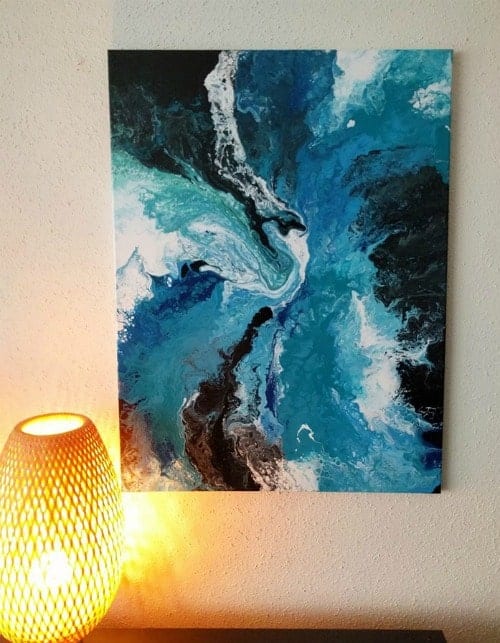“OOh, nice cells!” “Wow, look at all those cells!” “Can you tell me how you got all those huge cells?” “I love the cells in this one.”
Are you obsessed with the ‘cells’ that you can get in acrylic pouring? I admit I love them, but sometimes it’s a love-hate relationship. They are difficult to control. Sometimes you might want cells and they just don’t happen today. Other times you might want a few cells and you get far more than you bargained for and the painting might look too ‘busy’. Sometimes you might torch for a few cells and then get them all over like a rash – and you decide you preferred it before! Torching is one decision on a painting design that you simply can’t take back.

I laughed out loud at a comment in the Facebook group last week when one member likened too many cells to a nasty case of smallpox. So true, sometimes too many is worse than none at all. Much worse. I’ve had this plenty of times where I wish I had just left it as it was.
Although many of us strive to get cells in our paintings through working out a magic recipe or formula that seems to work for us and our paint brands, it’s not always necessary to cover the canvas with cells in order to create a truly awesome painting. Acrylic pouring and flow art is all about the flow and movement of the paint, the blending of the colors, the overall composition as well as the tiny details. I’ve seen some truly amazing poured pieces that don’t have any cells at all and still they are mesmerizing.

I don’t think I’m alone in really enjoying all the paintings without cells. Two of the most popular threads in our Facebook Group over the last couple of weeks have been sharing threads for paintings without cells. Everyone has embraced them enthusiastically and shared all their best works without a cell in sight. What a wonderful collection of art it is.
I encourage you to come on over to our Facebook Group and check out these two threads full of the most awesome poured paintings where cells aren’t needed to create beautiful art. If you aren’t a member, you will need to apply to join before you can see the threads I think, but I’ll approve your application as soon as I can.

Charlotte asked “Anyone do pretty pours without cells? Would love to see some!”
Brian asked “I would love to see some pours without the fancy additives, silicone, and alcohol”
So, in conclusion, no, you and your paintings are not failures if you don’t get cells. It is not the only measure by which a poured painting is deemed a successful pour. You can have a thousand cells but if your color scheme is making you queasy then it’s not a successful painting (oh yes I’ve made plenty of horrible color choices). The most elegant, striking and successful pours need not have any cells at all to be 100% glorious.
Embrace the randomness of the pour. Go with the flow. Don’t worry that your painting is not a success unless you have cells. There are far more important things in creating art than cells. Be different, have fun, enjoy and relax.
After being told in high school that she was so bad at art that she should switch to another subject, Deby didn’t paint again for 35 years. Then a stroke released a new wave of creativity and she began exploring with dot painting, abstract and eventually acrylic pouring, and at last the joy of working with color returned. You don’t need ‘talent’ to be an acrylic pouring artist – just enthusiasm, some basic instruction, and a willingness to try, fail and try again. Paint along with her and learn from her many mistakes, and you’ll soon make great art together.


So what additives do you use so you do not get cells?
So far as I know there is no additive you can add to the paint that will guarantee that you don’t get cells. Even paint and water poured in the right way gives cells. So sometimes it just happens any way.
No additive needed, just make sure all the paints have a matching density.
Where can I find what the density of
Paint is.? also many paints just sink to the bottom and it looks awful. Help
I’ve
Unless the manufacturer publishes a list it can be very difficult to know. You can try measuring out equal volumes of paint and then weighing them but it’s unlikely to give a really accurate result.
I use artisloft paints and Floetrol only. Sometimes a bit of water. Trying to avoid silicone as I see many pours on YouTube that have lots of cells.
This article makes me feel so much better. Still, I’m wondering what size canvas is needed to get those beautiful results?
I think to get the really bold looking paintings, you do need a larger canvas, say 16×20 inches or so. The smaller canvases often look better with something on a smaller scale for the design. But not always. I’ve seen some really bold small canvases too that only have 3 simple colors and they can look really striking.
I am the only one sick of cells? Every time I see a video/post about fluid painting it’s “cells this” and “cells that”.
Why the obsession?
When every painting is covered in the pattern cells make they all look the same. Sure the colors might be different, but when there’s a very common pattern in every painting it’s boring. It’s like every fluid artist is just copying the others.
Agree! I was fascinated the first several videos I saw with cells, but quickly tired of them. I just like a nice bold design with a lot
Of contrast and a few good colors
This was such a great piece! I have to go with my mood. Sometimes cells, sometimes not. I, too, have noticed an obsession with cells. I think because they are always a surprise. If the whole piece is cells, it is way too busy for me to look at. Like a mini explosion ? in my brain. Just flowing colors I find very calming. But each is beautiful in its’ own way!
So far, almost none of my pours have given me cells (I’d like to do ONE with cells, at least!).
And, yes, I’ve made some dubious colour choices…. and paint choices (one batch just seems to go “sucky sucky” on every other colour (drawing them in); end result was small areas of colour on a swampy background!)
So far I’d say 25% great, 50% “Hmm, OK”, 25% failure.
Can you tell me what,I did wrong on my first acrylic pours on yupo paper that I didn’t get cells? Could it be that my paint mixes were too thick or that my silicone was like a thick gooey serum or Should I have used silicone drops and thinner paint? I was afraid to torch it.
Thank you
I’m afraid without seeing it, and seeing exactly what you did, it would be impossible to say why you didn’t get cells. But don’t be disappointed, it’s quite normal for your first 2 or 3 to be a learning experience rather than a masterpiece. If you still continue to struggle, come share your recipe and a photo of your results in the chat group and we will try to help. http://facebook.com/groups/acrylicpouring
I don’t like the look of the cells I just want to know how to get rid of them I have not even started yet I just want to use my paints and modpodge is that going to work?
Sure, you can use and not use whatever materials gives you the results you are looking for. Just be aware though that it can be impossible sometimes to prevent cells forming in your paint if you use paints that have a variation in density. But if you use just paints and medium then most of the time you’ll be able to create a fluid painting without them.
Hello
Im very new to this cell fascination. I have only started doing art less than a month.
I‘ve watched hours of all you’re excellent videos, however I’m unable to achieve cells that often.
I followed the directions, and pleased with most pieces, I also have some nice results.
I would love some advice and comments.
The easiest way to get some help with this is to come and join our chat group. Post up the products you are using, your recipe and some photos of your typical results and the members will try to diagnose the problem and help you get more consistent results.
You can get a chart with pigment and paint densities from Golden Art 🙂
While shopping at Michaels I came across a display of Artist Loft “Ready Pour Paints” that were on sale. I purchased a set and then started watching videos to see what to do with them. I instantly became an addict. However…. I have some major problems! First, although the paint is “ready to pour”, it is often too thick. I have tried using The Artist Loft Pouring Medium to thin it… and also just using plain water. I struggle with maintaining a recipe that I can duplicate or one that works consistently. Of course I have also purchased other colors of the Ready To Pour paint and now need to use it up before I begin mixing my own. Second, I had some leftover house paint and after seeing several artist use this as their “base”, I decided to try using it as my basecoat. Here again, I am still struggling with getting the right consistency with a mix of house paint and water… or a mix of house paint and Floetrol. It’s either too thick… or too thin. I have also tried mixing house paint with Floetrol and that creates a lot of cells in the negative space. HELP! Please!! Thank you.
I enjoy the natural cells I get just by using Floetrol & water. I’m not a big fan of cells but do embrace them should it happen unexpectedly.
BARBARA WALTHOUR the best way to make sure all your paints have the same density is to use the same amount of paint and water for each color then I use a piece of cardboard or paper plate and drop a dot of each color next to each other and then turn it where the paint runs. There will be some that don’t drip as fast, even with exact measurements. Adjust til they all drip evenly.
Thank you for the advice Bonnie… sounds good 🙂